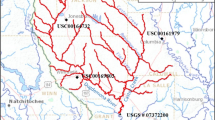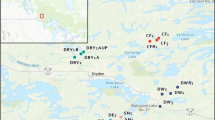Abstract
Forestry has been reported to cause elevated mercury (Hg) concentrations in runoff water. However, the degree to which forestry operations influence Hg in runoff varies among sites. A synoptic study, covering 54 catchments distributed all over Sweden, subjected to either stump harvest (SH), site preparation (SP) or no treatment (Ref), was undertaken to reveal the degree of forestry impact and causes of eventual variation. All streams were sampled twice, in autumn 2009 and summer 2010. There were no significant differences in total mercury (THg) and methylmercury (MeHg) concentrations between the three treatments in either 2009 or 2010. However, when pooling the treated catchments (that is, SH and SP) and taking catchment properties such as latitude into account, the treatment had a significant influence on the THg and MeHg concentrations. Although the treatment effect on THg and MeHg did not differ between SH and SP, the study did reveal significant forestry effects on potassium (K) and total nitrogen (TN) that were greater in the SH catchments and lower in the SP catchments. Partial least square (PLS) regressions indicated that organic matter was the most important variable influencing both the THg and MeHg concentrations. There were no significant differences between the treatment groups when comparing the ratios of THg/total organic carbon (TOC) and MeHg/TOC, suggesting that the high concentrations of THg and MeHg observed at some of the treated catchments are associated with increased concentrations of TOC rather than new methylation or increased mobilization caused by factors other than TOC.





Similar content being viewed by others
References
Åkerblom S, Nilsson MB, Yu J, Ranneby B, Johansson K. 2012. Temporal change estimation of mercury concentrations in northern pike (Esox lucius L.) in Swedish lakes. Chemosphere 86:439–45.
Allan CJ, Heyes A, Mackereth RJ. 2009. Changes to groundwater and surface water Hg transport following clearcut logging: a Canadian case study. In: Does forestry contribute to mercury in Swedish fish? Royal Swedish Academy of Agriculture and Forestry (KSLA), Kungl.skogs-och lantbruksakademins tidskrift 148:50–4. http://www.ksla.se/wp-content/uploads/2011/03/KSLAT-2009-1-Forest-mercury.pdf#page=50. Accessed 25 May 2012.
Bishop K, Allan C, Bringmark L, Garcia E, Hellsten S, Högbom L, Johansson K, Lomander A, Meili M, Munthe J, Nilsson M, Porvari P, Skyllberg U, Sørensen R, Zetterberg T, Åkerblom S. 2009. The effects of forestry on Hg bioaccumulation in nemoral/boreal waters and recommendations for good silvicultural practice. Ambio 38:373–80.
Bishop KH, Lee YH. 1997. Catchments as a source of mercury/methylmercury in boreal surface waters. In: Sigel H, Sigel A, Eds. Mercury and its effects on environment and biology; metal ions in biological system, Vol. 34. New York: Marcel Dekker Inc. p 113–30.
Bishop K, Lee YH, Pettersson C, Allard B. 1995. Terrestrial sources of methylmercury in surface waters: The importance of the riparian zone on the Svartberget catchment. Water Air Soil Pollut 80:435–44.
Brigham ME, Wentz DA, Aiken GR, Krabbenhoft DP. 2009. Mercury cycling in stream ecosystems. 1. Water column chemistry and transport. Environ Sci Technol 43:2720–5.
Driscoll CT, Blette V, Yan C, Schofield CL, Munson R, Holsapple J. 1995. The role of dissolved organic carbon in the chemistry and bioavailability of mercury in remote Adirondack lakes. Water Air Soil Pollut 80:499–508.
Drott A, Lambertsson L, Björn E, Skyllberg U. 2007. Importance of dissolved neutral mercury sulfides for methyl mercury production in contaminated sediments. Environ Sci Technol 41:2270–5.
Egnell G, Laudon H, Rosvall O. 2011. Perspectives on the potential contribution of Swedish forests to renewable energy targets in Europe. Forests 2:578–89.
Eklöf K, Fölster J, Sonesten L, Bishop K. 2012a. Spatial and temporal variation of THg concentrations in run-off water from 19 boreal catchments, 2000–2010. Environ Pollut 164:102–9.
Eklöf K, Meili M, Åkerblom S, von Brömssen C, Bishop K. 2012b. Impact of stump harvest on run-off concentrations of total mercury and methylmercury. Forest Ecol Manag. doi: 10.1016/j.foreco.2012.05.039.
Eriksson L, Johansson E, Kettaneh-Wold N, Wold S. 1999. Introduction to multi- and megavariate data analysis using projection methods (PCA & PLS). Umeå: Umetrics AB.
EU. 2008. Directive 2008/105/EC of the European Parliament and of the Council of 16 December 2008 on environmental quality standards in the field of water policy. Official Journal of the European Union 51/L348. pp. 84–97. http://eur-lex.europa.eu/LexUriServ/LexUriServ.do?uri=CELEX:32008L0105:EN:NOT. Accessed 25 May 2012.
Fitzgerald WF, Engstrom DR, Mason RP, Nater EA. 1998. The case for atmospheric mercury contamination in remote areas. Environ Sci Technol 32:1–7.
Gadmar TC, Vogt RD, Osterhus B. 2002. The merits of the high-temperature combustion method for determining the amount of natural organic carbon in surface freashwater samples. Int J Environ Anal Chem 82:451–61.
Garcia E, Carignan R. 2000. Mercury concentrations in northern pike (Esox lucius) from boreal lakes with logged, burned, or undisturbed catchments. Can J Fish Aquat Sci 57:129–35.
Garcia E, Carignan R, Lean DRS. 2007. Seasonal and inter-annual variations in methyl mercury concentrations in zooplankton from boreal lakes impacted by deforestation or natural forest fires. Environ Monit Assess 131:1–11.
Haitzer M, Aiken GR, Ryan JN. 2003. Binding of mercury(II) to aquatic humic substances: influence of pH and sources of humic substances. Environ Sci Technol 37:2436–41.
Ilyin I, Rozovskaya O, Sokovykh V, Travnikov O, Varygina M, Aas W, Uggerud HT. 2010. Heavy metals: Transboundary pollution of the environment. Meterological Synthesizing Centre—East & Chemical Co-Ordinating Centre. EMEP status report 2/2010.
Johansson K, Bergbäck B, Tyler G. 2001. Impact of atmospheric long-range transport of lead, mercury and cadmium on the Swedish forest environment. Water Air Soil Pollut Focus 1:279–96.
King JK, Kostka JE, Frischer ME, Saunders FM, Jahnke RA. 2001. A quantitative relationship that demonstrates mercury methylation rates in marine sediments are based on the community composition and activity of sulfate-reducing bacteria. Environ Sci Technol 35:2491–6.
Kreutzweiser DP, Hazlett PW, Gunn JM. 2008. Logging impacts on the biogeochemsitry of boreal forest soils and nutrient export to aquatic systems: a review. Environmental Reviews 16:157–79.
Lambertsson L, Björn E. 2004. Validation of a simplified field-adapted procedure for routine determinations of methyl mercury at trace levels in natural water samples using species-specific isotope dilution mass spectrometry. Anal Bioanal Chem 380:871–5.
Lee YH, Bishop KH, Munthe J. 2000. Do concepts about catchment cycling of methylmercury and mercury in boreal catchments stand the test of time? Six years of atmospheric inputs and runoff export at Svartberget, northern Sweden. Sci Total Environ 260:11–19.
Löfgren S, Ring E, von Brömssen C, Sørensen R, Högbom L. 2009. Short-term effects of clear-cutting on the water chemistry of two boreal streams in northern Sweden: a paired catchment study. Ambio 38:347–56.
Meili M, Iverfeldt Å, Håkanson L. 1991. Mercury in the surface of Swedish forest lakes—concentration, speciation and controlling factors. Water Air Soil Pollut 56:439–53.
Munthe J, Hultberg H. 2004. Mercury and methylmercury in runoff from a forested catchment—concentrations, fluxes, and their response to manipulations. Water Air Soil Pollut Focus 4:607–18.
Munthe J, Kindbom K, Kruger O, Petersen G, Pacyna J, Iverfeldt Å. 2001. Examining source-receptor relationships for mercury in Scandinavia; Modelled and empirical evidence. Water Air Soil Pollut Focus 1:299–309.
Munthe J, Wängberg I, Rognerud S, Fjeld E, Verta M, Porvari P, Meili M. 2007. Mercury in Nordic ecosystems. Nordic Council of Ministers (NMR), Copenhagen, Tema Nord/IVL Report B1761. pp. 1–44.
Pettersson C, Bishop K, Lee YH, Allard B. 1995. Relations between organic carbon and methylmercury in humic rich surface waters from Svartberget catchment in northern Sweden. Water Air Soil Pollut 80:971–9.
Porvari P, Verta M, Munthe J, Haapanen M. 2003. Forestry practices increased mercury and methyl mercury output from boreal forest catchments. Environ Sci Technol 37:2389–93.
Ravichandran M. 2004. Interactions between mercury and dissolved organic matter—a review. Chemosphere 55:319–30.
Reese H, Nilsson M, Pahlén TG, Hagner O, Joyce S, Tingelöf U, Egberth M, Olsson H. 2003. Countrywide estimates of forest variables using satellite data and field data from the national forest inventory. Ambio 32:542–8.
Rosén K, Lundmark-Thelin A. 1987. Increased nitrogen leaching under piles of slash—a consequence of modern forest harvesting techniques. Scand J For Res 2:21–9.
Scherbatskoy T, Shanley JB, Keeler GJ. 1998. Factors controlling mercury transport in an upland forested catchment. Water Air Soil Pollut 105:427–38.
Shanley JB, Bishop KH. 2012. Hg cycling in terrestrial watersheds. In: Bank MS, Ed. Mercury in the environment: pattern and process. Berkeley: University of California Press. p 117–39.
Skyllberg U, Drott A, Lambertsson L, Björn E, Karlsson T, Johnson T, Heinemo S-Å, Holmström H. 2007. Net methylmercury production as a basis for improved risk assessment of mercury-contaminated sediments. Ambio 36:437–42.
Skyllberg U, Westin MB, Meili M, Björn E. 2009. Elevated concentrations of methyl mercury in streams after forest clear-cut: a consequence of mobilization from soil or new methylation? Environ Sci Technol 43:8535–41.
Sørensen R, Meili M, Lambertsson L, von Brömssen C, Bishop K. 2009a. The effect of forest harvest operations on mercury and methylmercury in two boreal streams: relatively small changes in the first two years prior to site preparation. Ambio 38:364–72.
Sørensen R, Ring E, Meili M, Högbom L, Seibert J, Grabs T, Laudon H, Bishop K. 2009b. Forest harvest increases runoff most during low flows in two boreal streams. Ambio 38:357–63.
Tripler CE, Kaushal SS, Likens GE, Todd Walter M. 2006. Patterns in potassium dynamics in forest ecosystems. Ecol Lett 9:451–66.
US EPA. 2002. Mercury in water by oxidation, purge and trap, and cold vapor atomic fluorescence spectrometry. Method 1631, Revision E. Report EPA-821-R-02-019. Unites States Environmental Protection Agency, Washington.
Vitousek PM, Reiners WA. 1975. Ecosystem succession and nutrient retention: a hypothesis. Bioscience 25:376–81.
Walley FL, Van Kessel C, Pennock DJ. 1996. Landscape-scale variability of N mineralization in forest soils. Soil Biol Biochem 28:383–91.
Walmsley JD, Godbold DL. 2010. Stump harvesting for bioenergy—a review of the environmental impacts. Forestry 83:17–38.
Wold S, Sjöström M, Eriksson L. 2001. PLS-regression: a basic tool of chemometrics. Chemom Intell Lab Syst 58:109–30.
Acknowledgements
This study was funded by the Swedish Energy Agency, the Swedish University of Agricultural Sciences, MISTRA Future Forests and the forest companies Sveaskog, Stora Enso and Skogssällskapet. Great help with identifying the treated catchments in this study was provided by Skogforsk and the forestry companies SCA, Södra skogsägarna, Skogssällskapet, Sveaskog and Holmen skog. We thank all people involved in the field sampling campaign and especially Anders Larson who also helped during the preparation period of this study. We also thank Ulf Skyllberg, Martyn Futter and Emma Göthe for valuable comments on the manuscript and Andrew Henry for helping with the GIS calculations.
Author information
Authors and Affiliations
Corresponding author
Additional information
Author Contributions
KE wrote the paper, designed the study, preformed research and analyzed the data. AK, GW and MM contributed to data analysis and helped in writing the paper. KB conceived the project, performed research, contributed to the data analysis and helped in writing the paper.
Electronic supplementary material
Below is the link to the electronic supplementary material.
Rights and permissions
About this article
Cite this article
Eklöf, K., Kraus, A., Weyhenmeyer, G.A. et al. Forestry Influence by Stump Harvest and Site Preparation on Methylmercury, Total Mercury and Other Stream Water Chemistry Parameters Across a Boreal Landscape. Ecosystems 15, 1308–1320 (2012). https://doi.org/10.1007/s10021-012-9586-3
Received:
Accepted:
Published:
Issue Date:
DOI: https://doi.org/10.1007/s10021-012-9586-3




